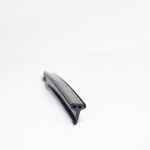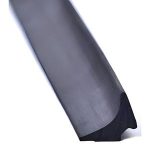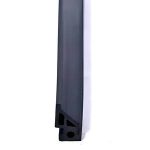EPDM Rubber Seals: Versatile and Reliable Sealing Solutions for Diverse Applications
EPDM (Ethylene Propylene Diene Monomer) rubber seals are an essential class of sealing materials known for their outstanding properties and versatility. These seals are widely used across various industries and applications, playing a pivotal role in ensuring leak-free connections, weatherproofing, and environmental protection. In this comprehensive overview, we will delve into the key features, types, materials, manufacturing processes, applications, benefits, and considerations related to EPDM rubber seals.
1. Key Features of EPDM Rubber Seals:
- Exceptional Weather Resistance: EPDM rubber seals are renowned for their outstanding resistance to environmental elements, including sunlight (UV radiation), ozone, and extreme temperatures. This makes them ideal for both indoor and outdoor applications where exposure to harsh conditions is common.
- Chemical Resistance: EPDM rubber exhibits resistance to a wide range of chemicals, acids, alkalis, and solvents, making it versatile for applications involving exposure to various substances.
- Elasticity and Flexibility: EPDM rubber seals possess high elasticity, allowing them to stretch and recover their original shape after deformation. This property enables a secure and reliable seal even under varying pressures or mechanical stresses.
- Superior Thermal Stability: They can withstand a broad temperature range, from sub-zero conditions to high heat, without losing their sealing effectiveness.
- Low Gas Permeability: EPDM rubber exhibits low gas permeability, making it effective in applications requiring gas-tight seals.
- Electrical Insulation: EPDM has good electrical insulating properties, which makes it suitable for use in electrical enclosures and insulating applications.
- Low Toxicity: EPDM rubber is known for its low toxicity and is safe for use in applications where contact with food, drinking water, or potable liquids is a consideration.
2. Types of EPDM Rubber Seals:
EPDM rubber seals come in various forms to suit specific sealing requirements:
- Extruded Profiles: These are custom-shaped EPDM rubber profiles created through extrusion, tailored to fit the unique needs of different applications.
- O-Rings: EPDM O-rings are circular sealing elements that fit into grooves or recesses and are widely used in hydraulic and pneumatic systems.
- Gaskets: EPDM rubber gaskets are flat or irregularly shaped sealing elements used between two surfaces to create a seal, often found in plumbing and industrial applications.
- Tubing and Cord: EPDM rubber is available in the form of tubing or cord, which can be cut to size and used for various sealing and insulating purposes.
3. Materials and Manufacturing Process:
- Material Composition: EPDM rubber is synthesized from ethylene, propylene, and a diene monomer. Various formulations are available to meet specific application requirements, such as temperature resistance, chemical compatibility, and hardness.
- Manufacturing Process: EPDM rubber seals are typically manufactured through processes like extrusion, molding, cutting, and vulcanization, where the rubber is formed into the desired shape and cured for strength and durability.
4. Applications:
EPDM rubber seals find applications in numerous industries and sectors, including:
- Automotive: EPDM rubber is extensively used for gaskets, weatherstripping, seals, and hoses in vehicles.
- Construction: It is employed in building and construction for weatherstripping, window seals, roofing, HVAC systems, and expansion joint covers.
- Electrical and Electronics: EPDM gaskets and seals are used in electrical enclosures, control panels, and cable management systems.
- Aerospace: They are used in aircraft components, such as door seals, window seals, and gaskets, due to their resistance to aviation fluids and temperature extremes.
- Water and Wastewater: EPDM rubber seals are used in plumbing, water treatment, and sewer systems to create watertight connections.
- Marine: They are used in marine applications for sealing hatches, portholes, boat windows, and equipment exposed to saltwater and UV radiation.
- Food and Beverage: EPDM gaskets are safe for use in food processing equipment, where contact with food or beverages is common.
- Industrial: EPDM rubber is used in various industrial equipment, machinery, and pumps for sealing and insulating purposes.
5. Benefits:
- Reliable Sealing: EPDM rubber seals provide a reliable and long-lasting seal, reducing the risk of leaks and maintaining the integrity of the enclosed environment.
- Durability: They are known for their durability and resistance to wear, ensuring a long service life.
- Cost-Effective: EPDM rubber seals offer a cost-effective sealing solution due to their longevity and performance.
- Environmental Resistance: EPDM rubber performs well in outdoor and harsh environments, resisting damage from weather and UV radiation.
- Versatility: Their broad chemical resistance and temperature tolerance make EPDM rubber seals versatile and suitable for diverse applications.
6. Considerations:
- Compatibility: Ensure compatibility with the specific application, as EPDM may not be suitable for certain chemicals or high-pressure applications.
- Material Grade: Select the appropriate EPDM material grade to match the application’s requirements, such as temperature, chemical exposure, and hardness.
In conclusion, EPDM rubber seals are indispensable components in various industries, contributing to leak-free connections, weatherproofing, and environmental protection. Their reliability, durability, and versatility make them essential for ensuring the integrity and performance of systems, equipment, and structures in diverse applications. Proper material selection, installation, and maintenance are crucial to maximizing the benefits of EPDM rubber seals in industrial and commercial settings.






